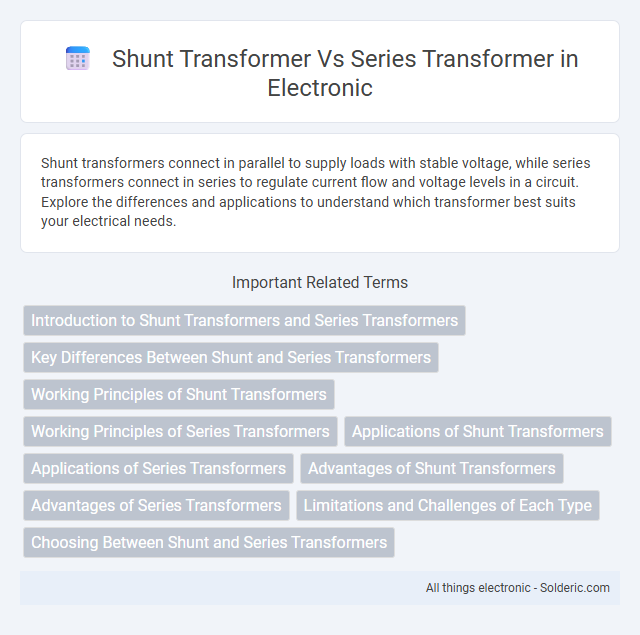Shunt transformers connect in parallel to supply loads with stable voltage, while series transformers connect in series to regulate current flow and voltage levels in a circuit. Explore the differences and applications to understand which transformer best suits your electrical needs.
Comparison Table
| Feature | Shunt Transformer | Series Transformer |
|---|---|---|
| Connection Type | Connected in parallel (shunt) with the load | Connected in series with the load |
| Main Purpose | Voltage regulation and power factor correction | Current regulation and controlling load current |
| Voltage Characteristics | Maintains constant voltage across the load | Varies voltage drop to control current flow |
| Current Characteristics | Draws current proportional to load voltage | Carries load current directly in series |
| Application | Power factor correction, voltage stabilization | Current limiting, protection, and control |
| Impedance | Impedance connected in parallel | Impedance inserted in series |
| Effects on Load | Maintains voltage, minimally affects current | Directly influences current and voltage drop |
Introduction to Shunt Transformers and Series Transformers
Shunt transformers are designed to operate in parallel with the load, providing voltage regulation and reactive power compensation, which helps stabilize your power system. Series transformers, on the other hand, are connected in series with the load to control current flow and manage voltage drop, enhancing system stability under varying load conditions. Understanding the distinct roles of shunt and series transformers is essential for optimizing electrical network performance and improving energy efficiency.
Key Differences Between Shunt and Series Transformers
Shunt transformers are connected parallel to the load and primarily control voltage by supplying reactive power, whereas series transformers are connected in series with the load to regulate current by adding or subtracting voltage. Shunt transformers offer voltage stabilization in power systems while series transformers are used for voltage regulation and fault current limitation. Understanding these distinctions helps optimize Your electrical network for efficiency and reliability.
Working Principles of Shunt Transformers
Shunt transformers operate by connecting their secondary winding in parallel with the load, allowing them to regulate voltage and provide reactive power compensation independently from the main power flow. They function by drawing a magnetizing current to maintain voltage stability and support power factor correction in electrical systems. This parallel connection distinguishes shunt transformers from series transformers, which are placed in series to directly influence load current and impedance.
Working Principles of Series Transformers
Series transformers operate by being connected in series with the load, where the primary winding carries the load current directly, inducing a voltage in the secondary winding based on the turns ratio. Your power system benefits from voltage regulation and current control through this direct series connection, which adjusts voltage levels to stabilize sensitive equipment. Unlike shunt transformers that work in parallel for voltage support, series transformers manage fault currents and improve power quality by injecting voltage drop in series with the transmission line.
Applications of Shunt Transformers
Shunt transformers are primarily used in electrical power systems for voltage regulation and reactive power compensation, often connected in parallel with the load to stabilize voltage levels. They find applications in industrial settings, electric traction, and power factor correction where maintaining a consistent voltage is crucial. Your system benefits from shunt transformers when improving voltage stability and enhancing efficiency without interrupting the load current.
Applications of Series Transformers
Series transformers are primarily used in power system applications for voltage regulation, load balancing, and isolation purposes. They help in controlling voltage variations by adding or subtracting voltage in series with the line, making them suitable for applications like power line compensation, fault current limiting, and harmonic reduction. Industries utilize series transformers to improve power quality and ensure stable operation of electrical equipment in distribution networks.
Advantages of Shunt Transformers
Shunt transformers offer significant advantages such as providing stable voltage regulation and efficient load sharing by operating in parallel with the power source. They improve the overall reliability of electrical systems by isolating faults and maintaining continuity of supply. Your electrical network benefits from reduced losses and enhanced voltage stability when utilizing shunt transformers compared to series transformers.
Advantages of Series Transformers
Series transformers provide improved voltage regulation by adjusting voltage levels directly within the power line, resulting in enhanced system stability and efficient load sharing. Their design allows for simple integration into existing circuits, making them ideal for applications requiring voltage step-up or step-down without extensive modifications. You benefit from reduced power losses and increased electrical isolation, which contribute to safer and more reliable power distribution.
Limitations and Challenges of Each Type
Shunt transformers face limitations in handling high reactive power and can cause voltage regulation issues under varying loads due to their parallel connection. Series transformers encounter challenges in maintaining system stability, as any fault or failure directly affects the entire series circuit, leading to potential safety hazards. Your choice must consider these constraints to ensure optimal performance in specific electrical network applications.
Choosing Between Shunt and Series Transformers
Choosing between shunt and series transformers depends on your specific application needs; shunt transformers are ideal for voltage regulation and power supply isolation, while series transformers are suited for current regulation and impedance matching. Shunt transformers connect in parallel with the load, providing voltage stability, whereas series transformers connect in series, controlling current flow and protecting circuits from surges. Understanding load requirements and desired performance ensures you select the optimal transformer type for efficiency and reliability.
shunt transformer vs series transformer Infographic

 solderic.com
solderic.com